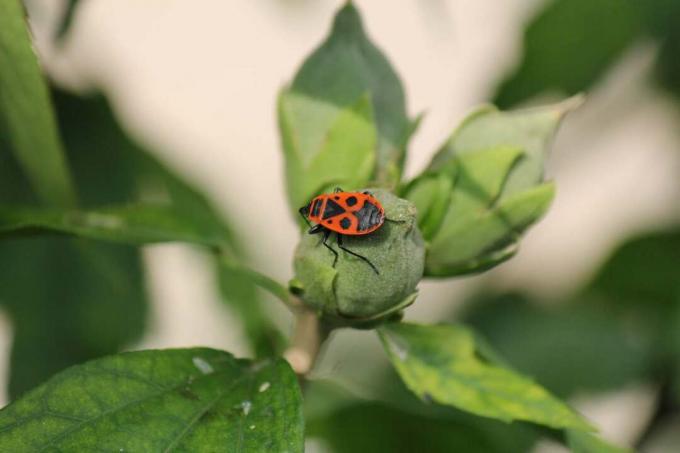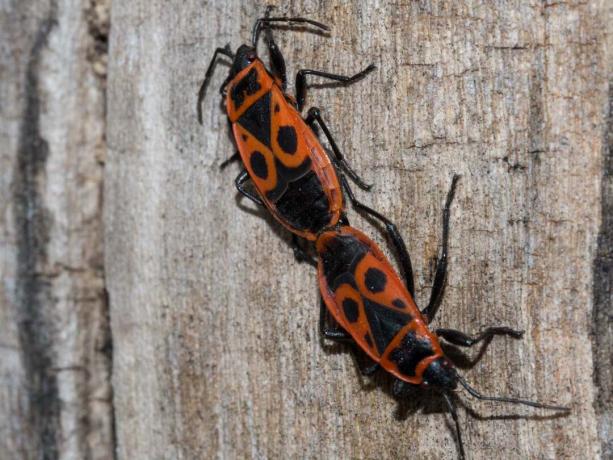Fire bugs often appear in large flocks in the garden. But are the bedbugs poisonous and do you have to fight them? We have helpful tips ready for you.
The fire bug (Pyrrhocoris apterus) is a native species of bugs, named for its bright red shield. In spring, when the sun shines longer again, the fire bugs come out of their ground caves in large numbers (usually under leaves or pieces of bark) to get out of hibernation on warmed-up places such as stones or tree trunks awakening.
contents
- Fire bugs: harmful, dangerous or poisonous?
- Fire bugs in the garden: fight or not?
- Drive away fire bugs
- Fire bugs: profile of an important insect
Fire bugs: harmful, dangerous or poisonous?
Fire bugs rarely have natural enemies. With birds, they are at the bottom of the menu because they have a very bitter taste and their warning color indicates that they want to be left alone.
The animals are not poisonous and do not spray any caustic liquids. If you touch them, however, they can give off a foul-smelling secretion in case of danger.
They ingest their food in liquid form through a proboscis. For food intake, their proboscis bores a hole in the shell of fallen seeds or Fruits, leaves a decomposing secretion and then sucks the resulting nutrient-rich juice a.
Prefer fire bugs Linden trees (Tilia) and mallow family (Malvaceae), especially here Hollyhocks (Alcea rosea) and the shrub marshmallow (Hibiscus syriacus). But dead insects are also occasionally used as a source of food.
In general, fire bugs are not considered to be a threat to plant health. With a particularly high incidence of the fiery red annoyance, however, it can lead to increased damage to the buds of your beloved rose plants. That usually remains - thank God - but the exception.

Fire bugs in the garden: fight or not?
Usually you have to have fire bugs (Pyrrhocoris apterus) do not fight. They cannot sting people and there is no other danger from them. Only if you touch it and irritate it, but remove the foul-smelling secretion.
If individual fire bugs get lost in the house, it is easy to catch them with a piece of paper and an upside-down glass and to carry them out again.
Often, however, they occur in large numbers, which can be quite annoying in the long run (they are therefore sometimes referred to as "nuisances"). For example, when they gather on house walls or on terraces or whole on sunny days Besieging bushes in the garden, then maybe you would like to have such a "gathering" from time to time. dissolve.

The use of chemical agents or natural contact insecticides is nevertheless not recommended. If you try to use chemicals to get rid of fire bugs, you put others at risk too Beneficial insects in the garden.
A natural but effective means of fighting fire bugs is a mixture of half a liter of water and one to two tablespoons of dish soap. Both are put in a spray bottle. The nests or collections are sprayed with it so that the animals perish within a short time. But even this “home remedy” must be used carefully and purposefully.
Drive away fire bugs
If you want to spare the animals, but still want to compliment them from your garden, then only a broom and dustpan and a place far away from the garden will help.
However, if there are mallow plants (Malvaceae), and linden trees (Tilia) in your yard, you will almost certainly be visited by fire bugs again soon.
Our tip: Take it easy and just tolerate the red sign bearers.
Fire bugs: profile of an important insect
The fire bug (Pyrrhocoris apterus) is a native species of bug. It is distributed almost everywhere in Europe and also in large parts of Asia with over 300 species.
It is popularly referred to as a cobbler or fire beetle, although it is actually not a beetle. Its distinctive color, consisting of a bright red shield with a black pattern and a black head, has probably also given it its name.

Your body reaches a length of up to 12 millimeters. Fire bugs feed on seeds (preferably linden seeds (Tilia)). Your mouth tool is a proboscis with which you pierce the seeds, release a decomposing secretion and then suck out the juice. Other dead insects are also on their menu.
The fire bugs hibernate protected on the ground under stones, bark or leaves. On warm and sunny spring days from mid-March they come out of their winter quarters and come together in large groups. Usually mating takes place in April and May. Copulation can take several hours to days. A female fire bug mates with several males. The males try to prolong the copulation period as long as possible so that no competitor can mate with the same female afterwards. That is why you can often see two fire bugs hanging together for a seemingly endless time.
Shortly after mating, the females lay between 60 and 80 eggs under stones or leaves. The hatched larvae molt five times until they are fully grown. Only one new generation is trained each year, with an average lifespan of 14 months. If the temperatures drop to -15 ° C or even below in very cold winters, many animals do not survive.
tip: Fire bugs are common with the less common ones Fire beetles mistaken. In our special article we present the insect in more detail.



